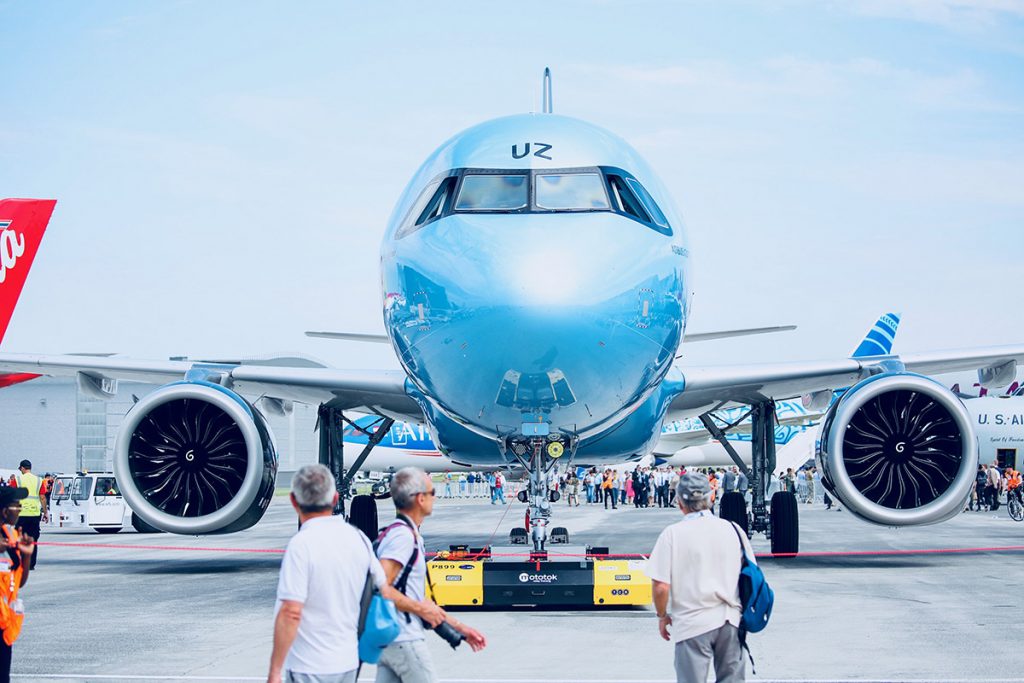
June 20, 2019

BIG DEALS, BIG ENGINES AND A BIG BIRTHDAY PARTY
“It has been an absolutely incredible week,” said Gaël Méheust, president and CEO of CFM International, at the midpoint of the Paris Air Show — the world’s largest annual gathering of aviation enthusiasts, industry experts, and the aircraft they love. Méheust spoke for everyone. A 50-50 joint venture between GE and Safran Aircraft Engines, CFM International kicked off the airshow with a bang by announcing it had inked the single-largest jet engine deal in history — with Indian carrier IndiGo, which will use the CFM LEAP engine to outfit 280 planes in its rapidly growing fleet. That announcement was followed by word of another huge order from AirAsia for LEAP engines and long-term services. CFM and GE left Paris with deals totaling about $55 billion — not a bad haul.
For the long haul: But the show wasn’t all business — it was also cause for celebration. In Paris, GE Aviation toasted to 100 years in operation, bringing along a historical gem that highlighted its progress: the aviation division’s very first aircraft offering, a turbosupercharger. Originally intended for a gas turbine to generate electricity, the machine found a second life in the air, allowing early planes to retain their power at high altitudes. That development was an initial step in a long road of triumphs and innovations, which continued in Paris as GE Aviation unveiled the GE9X — the largest commercial jet engine in the world, designed for Boeing’s new wide-body 777X passenger jet.
GE Aviation also went to Paris to highlight the software making air travel smarter, smoother and more efficient than ever — and that heralds the future of aviation. “Twenty years from now, the industry won’t be the same,” said Allen Paxson, the highest-ranking GE executive at CFM International. Click here to learn how GE is out in front of that change, and for other reflections on a big week at the Paris Air Show.
MORE MILES FOR SINGLE-AISLES
Folks in Paris also got a glimpse of a new breed of plane: the single-aisle jet that effortlessly makes trans-Atlantic flights. Typically, those long-haul trips are the province of large, wide-body jets with two to four engines. But thanks to the CFM LEAP engine, it’s now possible to take a smaller craft across the pond on one tank of fuel, while also lowering carbon emissions, oxides of nitrogen emissions and noise. This past May, the business-class-only airline La Compagnie started booking daily Newark, New Jersey-to-Paris flights on the next-gen single-aisle Airbus A321neo jet — one specimen of which was on display in the City of Light. The LEAP engines gleaming under its wings reflected the future of ultra-efficient air travel.
Flight of fancy: What makes these machines so special? With the LEAP engine, designers were able to slash fuel consumption by 15% over its predecessor by using a combination of new-wave manufacturing techniques and innovative materials. As machines like the LEAP engine make longer distances possible for smaller craft, single-aisle jets have become the fastest-growing segment of the airline industry. And the Atlantic Ocean is just the beginning: In a test flight last year, for instance, a LEAP-engine-powered Airbus A321neo LR took 162 dummy passengers and 16 crew from Toulouse, France, to the Seychelles islands in the Indian Ocean — an 11-hour voyage.
Want to know more about this superefficient engine? Go ahead — take the leap.
ANALYZE THIS
Between the single-aisle jet that hops between the U.S. and Europe (see above) and the largest jet engine in the world (see below), there was plenty for spectators to take in at the Paris Air Show. But there’s a lot more to the future of air travel than meets the eye — namely the data that’s transforming the aerospace industry, invisibly generated every second of every flight. In Paris, GE Aviation also rolled out a host of new partnerships and innovations that herald the digital age of aviation. Though experts have waxed poetic about this moment for years, it seems that it has finally arrived: “We’ve had a vision, and now we’re actually executing a plan,” said Jon Dunsdon, GE Aviation’s chief technology officer.
Data with destiny: That plan starts with pilots, who can have a huge impact on an airline’s safety, fuel efficiency, cost savings and other factors — and who now can take advantage of a suite of GE Aviation digital tools that help them make the best decisions. FlightPulse, for instance, lets pilots analyze data in order to use less fuel. “What programs like these do is help the individual see the impact of what they are doing,” Dunsdon said. In Paris, visitors to the GE “chalet” could play around with the latest preflight version of FlightPulse: Simulating preparations for an upcoming flight, they could tap into the collective knowledge of other pilots who’d plied the same route, getting an idea of which routes require more fuel or where safety concerns might crop up.
That’s just one piece of the digital services GE Aviation is developing — which are all part of a larger vision, Dunsdon said: “We want to create a comprehensive single version of what’s happened to the aircraft since it left the factory.” Learn more here.
GE GIANT EXPLAINED IN PICTURES
The deals that GE and CFM International made at the Paris Air Show are bound for the record books. But speaking of big deals: Also in Paris, GE Aviation President and CEO David Joyce unveiled the GE9X, the world’s largest commercial jet engine. The GE9X is practically made out of superlatives, but perhaps you’d rather see something worth a thousand words ...
... like an infographic. Click here for an illustrated exploration of the next giant of flight.
— VIDEO OF THE WEEK —
— QUOTE OF THE DAY —
“We want to be ready for the next upgrade, we want to be ready for the next engine, we want to be ready for the next generation in this industry.”
— Allen Paxson, executive vice president of CFM International
Quote: GE Reports. Image: Alex Schroff for GE Reports.
ENJOY THIS NEWSLETTER?
Please send it to your friends and let them know they can subscribe here.




